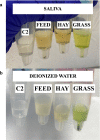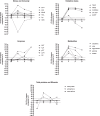Changes in salivary analytes in cows due to the in vitro presence of feed
- PMID: 35836175
- PMCID: PMC9281046
- DOI: 10.1186/s12917-022-03371-9
Changes in salivary analytes in cows due to the in vitro presence of feed
Abstract
Background: The effect in a sialochemistry profile of the presence of usually available feed in dairy cows was evaluated by an in vitro experiment. For this purpose, a pooled clean saliva from five healthy dairy cows was incubated five times with a standard feed based on a total mixed ration (F), wheat hay (H), and grass (G). The salivary panel was integrated by biomarkers of stress (cortisol -sCor-, salivary alpha-amylase -sAA-, butyrylcholinesterase -BChE-, total esterase -TEA-, and lipase -Lip-), immunity (adenosine deaminase -ADA-), oxidative status (Trolox equivalent antioxidant capacity -TEAC-, the ferric reducing ability of saliva -FRAS-, the cupric reducing antioxidant capacity -CUPRAC-, uric acid, and advanced oxidation protein products -AOPP-), and enzymes, proteins, and minerals of general metabolism and markers of liver, muscle, and renal damage (aspartate aminotransferase -AST-, alanine aminotransferase -ALP-, γ-glutamyl transferase -gGT-, lactate dehydrogenase -LDH-, creatine kinase -CK-, creatinine, urea, triglycerides, glucose, lactate, total protein, phosphorus, and total calcium).
Results: Most of the evaluated analytes showed a coefficient of variations (CV) higher than 15% and/or significant changes compared with the clean saliva when feed was present. Some analytes, such as the oxidative status biomarkers (CV > 80%), AST (CV > 60%), or glucose (CV > 100%), showed significant changes with all the feed types tested. Others showed significant differences only with certain types of feed, such as LDH with F (CV > 60%) or triglycerides with F (CV > 100%) and H (CV > 95%). However, sCor or gGT remained unchanged (CV < 15%, P > 0.05) in all the treatments.
Conclusions: The presence of feed can produce changes in most of the analytes measured in cows' saliva, being of high importance to consider this factor when saliva is used as a sample to avoid errors in the interpretation of the results.
Keywords: Biomarkers; Cow; Feed contamination; Saliva; Sialochemistry.
© 2022. The Author(s).
Conflict of interest statement
The authors declare that they have no competing interests.
Figures



Similar articles
-
Changes in saliva analytes during pregnancy, farrowing and lactation in sows: A sialochemistry approach.Vet J. 2021 Jul;273:105679. doi: 10.1016/j.tvjl.2021.105679. Epub 2021 Apr 19. Vet J. 2021. PMID: 34148602
-
Changes in Saliva Analytes in Dairy Cows during Peripartum: A Pilot Study.Animals (Basel). 2021 Mar 9;11(3):749. doi: 10.3390/ani11030749. Animals (Basel). 2021. PMID: 33803247 Free PMC article.
-
Saliva as a Potential Source of Biomarkers in Cows with Metritis: A Pilot Study.Vet Sci. 2024 Sep 21;11(9):446. doi: 10.3390/vetsci11090446. Vet Sci. 2024. PMID: 39330825 Free PMC article.
-
Changes of salivary biomarkers under different storage conditions: effects of temperature and length of storage.Biochem Med (Zagreb). 2019 Feb 15;29(1):010706. doi: 10.11613/BM.2019.010706. Biochem Med (Zagreb). 2019. PMID: 30799975 Free PMC article.
-
Changes in Salivary Analytes of Horses Due to Circadian Rhythm and Season: A Pilot Study.Animals (Basel). 2020 Aug 24;10(9):1486. doi: 10.3390/ani10091486. Animals (Basel). 2020. PMID: 32846911 Free PMC article.
Cited by
-
The Antioxidant Effect of Selenium Is Enhanced by Cortisol Through Nrf2 Pathway in Bovine Endometrial Epithelial Cells.Animals (Basel). 2025 Apr 8;15(8):1075. doi: 10.3390/ani15081075. Animals (Basel). 2025. PMID: 40281910 Free PMC article.
-
Validation of the Measurement of Beta-Hydroxybutyrate and Non-Esterified Fatty Acids in Bovine Saliva: A Pilot Report.Life (Basel). 2025 May 26;15(6):854. doi: 10.3390/life15060854. Life (Basel). 2025. PMID: 40566507 Free PMC article.
-
Welfare Assessment in Pigs Using the Salivary Proteome.Animals (Basel). 2024 Jun 5;14(11):1703. doi: 10.3390/ani14111703. Animals (Basel). 2024. PMID: 38891749 Free PMC article. Review.
References
-
- Tvarijonaviciute A, Martínez-Subiela S, López-Jornet P, Lamy E. Saliva in Health and Disease The Present and Future of a Unique Sample for Diagnosis. 1st edition. Switzerland: Springer, Cham; 2020. doi: 10.1007/978-3-030-37681-9.
MeSH terms
Substances
LinkOut - more resources
Full Text Sources
Medical
Research Materials
Miscellaneous

